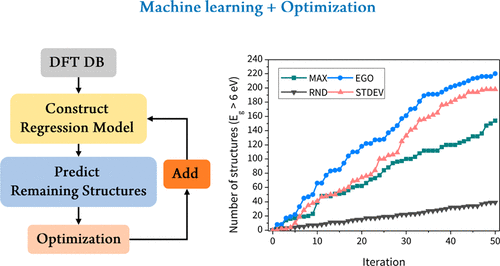当前位置:
X-MOL 学术
›
J. Phys. Chem. C
›
论文详情
Our official English website, www.x-mol.net, welcomes your
feedback! (Note: you will need to create a separate account there.)
Accelerated Discovery of Novel Inorganic Materials with Desired Properties Using Active Learning
The Journal of Physical Chemistry C ( IF 3.3 ) Pub Date : 2020-06-28 , DOI: 10.1021/acs.jpcc.0c00545 Kyoungmin Min 1 , Eunseog Cho 1
The Journal of Physical Chemistry C ( IF 3.3 ) Pub Date : 2020-06-28 , DOI: 10.1021/acs.jpcc.0c00545 Kyoungmin Min 1 , Eunseog Cho 1
Affiliation

|
Construction of prediction models using machine learning algorithms on existing databases expands the search limit of undiscovered structures, in principle, to the entire materials space. However, because of uncertainties in machine learning prediction, the suggested properties are not always promising; thus, improving the database quality is mandatory for validation as well as improvement in prediction accuracy. To achieve this, we herein implement an active learning process, beginning with a limited number of databases, to find materials satisfying target properties (band gap and refractive index) with minimized trials and errors. The regression model is initially trained with only around 2% of the entire search space, and 20 new databases, suggested from the optimization schemes, are added at each optimization process. Between exploration, exploitation, random selection, and the Bayesian optimization method, the Bayesian method exhibits the best performance in finding the number of materials that satisfies the criteria within limited trials In addition, the structure with the maximum target property values is found after searching only around 7.0% and 7.7% of the entire database for band gap and refractive index, respectively. Current results clearly confirm that the active learning process can be accelerated to find ideal materials satisfying target properties with minimized resources.
中文翻译:

主动学习加速发现具有所需特性的新型无机材料
在现有数据库上使用机器学习算法构建预测模型,原则上将未发现结构的搜索范围扩展到整个材料空间。但是,由于机器学习预测的不确定性,建议的属性并不总是有希望的;因此,提高数据库质量对于验证以及提高预测准确性都是必不可少的。为此,我们从有限数量的数据库开始实施主动学习过程,以找到满足目标特性(带隙和折射率)的材料,并尽量减少试验和误差。最初仅使用整个搜索空间的2%训练回归模型,并在每个优化过程中添加了根据优化方案建议的20个新数据库。在探索之间 利用,随机选择和贝叶斯优化方法,贝叶斯方法在寻找满足有限试验条件的材料数量方面表现出最佳性能。此外,仅在搜索约7.0%的材料后,才发现具有最大目标特性值的结构带隙和折射率分别占整个数据库的7.7%。目前的结果清楚地表明,可以加快主动学习过程,以最少的资源找到满足目标特性的理想材料。仅分别在整个数据库中搜索约7.0%和7.7%的带隙和折射率后,才能找到具有最大目标特性值的结构。目前的结果清楚地表明,可以加快主动学习过程,以最少的资源找到满足目标特性的理想材料。仅分别在整个数据库中搜索约7.0%和7.7%的带隙和折射率后,才能找到具有最大目标特性值的结构。目前的结果清楚地表明,可以加快主动学习过程,以最少的资源找到满足目标特性的理想材料。
更新日期:2020-07-09
中文翻译:

主动学习加速发现具有所需特性的新型无机材料
在现有数据库上使用机器学习算法构建预测模型,原则上将未发现结构的搜索范围扩展到整个材料空间。但是,由于机器学习预测的不确定性,建议的属性并不总是有希望的;因此,提高数据库质量对于验证以及提高预测准确性都是必不可少的。为此,我们从有限数量的数据库开始实施主动学习过程,以找到满足目标特性(带隙和折射率)的材料,并尽量减少试验和误差。最初仅使用整个搜索空间的2%训练回归模型,并在每个优化过程中添加了根据优化方案建议的20个新数据库。在探索之间 利用,随机选择和贝叶斯优化方法,贝叶斯方法在寻找满足有限试验条件的材料数量方面表现出最佳性能。此外,仅在搜索约7.0%的材料后,才发现具有最大目标特性值的结构带隙和折射率分别占整个数据库的7.7%。目前的结果清楚地表明,可以加快主动学习过程,以最少的资源找到满足目标特性的理想材料。仅分别在整个数据库中搜索约7.0%和7.7%的带隙和折射率后,才能找到具有最大目标特性值的结构。目前的结果清楚地表明,可以加快主动学习过程,以最少的资源找到满足目标特性的理想材料。仅分别在整个数据库中搜索约7.0%和7.7%的带隙和折射率后,才能找到具有最大目标特性值的结构。目前的结果清楚地表明,可以加快主动学习过程,以最少的资源找到满足目标特性的理想材料。











































 京公网安备 11010802027423号
京公网安备 11010802027423号